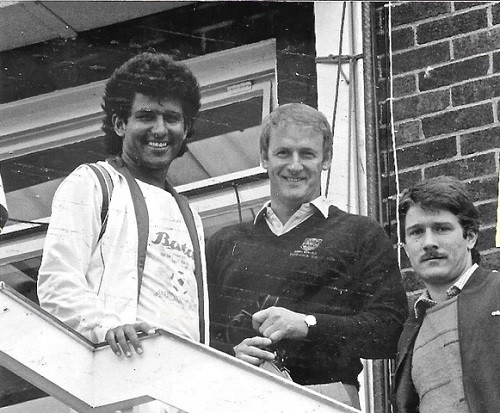
It is 25 years since Raman Lamba was killed playing cricket in Bangladesh and almost 40 years since he arrived in Ulster. Most of the current players were not even born, but most people are aware of his impact on Ulster cricket. The legend of Raman Lamba remains after 25 years and he should never be forgotten.
Twenty-four-year-old Raman Lamba entered Ulster cricket in May 1984 and he had a phenomenal season. A fourth choice at North Down, the committee couldn’t believe their good fortune after such a dismal last season. Raman was the most colourful cricket personality of his time, and arguably the best batsman of Irish cricket in his era. Yes, he courted controversy, but his cricket brilliance should never undermine his outstanding achievements.
We sometimes use the word ‘legend’ too casually, but Raman Lamba was certainly a legend, not only in Ulster cricket, but particularly in Comber. He loved the town, the people loved him, and the members loved him. He was an ebullient character, bubbling with personality, and revitalized a sleeping giant in NDCC. He was a great conversationalist after matches, and virtually every player had a story to tell about Raman. The media loved him, and his passion and enthusiasm were boundless, with great vision and far-reaching plans to promote Irish cricket to another level. He was a man before his time and never really accepted the amateur ethos in Ulster cricket. He lived for and loved his cricket, never drank, or smoked, was as fit as a fiddle, trained every day, practiced, or played most days, and felt everyone should be the same. He was the epitome of a professional cricketer.
North Down historian and Raman’s opening partner Ian Shields wrote in his Sesquicentenary book “One Shot More…for the Honour of Down-a History of North Down Cricket Cub 1857-2007”…
“No player in post-war Ulster cricket made a bigger impact than Raman Lamba. He was a legend in his time and gave the club a huge boost. Raman’s introduction to North Down and the Comber community became a life-changing experience for him and the beginning of a remarkable cricket journey for those who saw him play, and particularly for those who played with him.”
His legacy remains in the heart of The Green, North Down Cricket Club.
Raman Lamba was born on 2 January 1960 at Meerut, 45 miles from Delhi. He had four siblings, three sisters and a brother. From the outset, he was the darling in the family and always wanted to be a professional cricketer. India love crickets and it was estimated that over five million play the game. Raman had a daunting challenge, but he was an exceptional cricketer and reached the highest level. He made his debut in 1980 playing in the Ranji Trophy for Delhi. He was confident, athletic and a superb fielder. Indian cricket was strong at the time and opening batsmen had limited opportunities. When he arrived in Comber in 1984, he was well-known in Indian cricket circles, but not so much in Ireland, who were grappling with the concept of professional overseas players. Raman certainly changed the picture of Ulster and Irish cricket after his phenomenal first season. In his first four games, he accumulated 300 runs including a scintillating century at the Lawn, Waringstown, the bastion of amateur ethos in Ulster cricket at the time. Raman was aware of the occasion, but even the most hardened partisans gave him generous applause. It was an occasion that he was to repeat many times in Irish and Indian cricket, and the greater it was, the better he played. He loved to strut centre stage with great aplomb and assurance, a confident man that some skeptics interpreted as arrogant.
North Down was buzzing in 1984, and the legend of Raman Lamba began. Big crowds started to attend The Green, young players wanted him to coach them, and it was much easier to attract sponsors. Some of his team-mates chuckled it was the first-time good-looking ladies came to watch the games, but of course, it was Raman they wanted to see! After all, he was attractive, charismatic and had the looks of a movie star!
Raman scored 1,400 runs and took 40 wickets that season, but inadvertently met his first controversy of Irish cricket that he was never aware of. Raman hit 166 not out in the Schweppes Cup second round against Malahide after Brian Gilmore had scored 130 for the visitors and looked destined to win. Highly respected Irish Times correspondent Sean Pender ignited a barrage of criticism in Dublin circles and questioned the right of professional cricketers to play in midweek games as teams were weakened. Sean was a wise old sage and set the tone. When the ICU met at end of the season, he was the first person to break the news that the committee had banned overseas professionals the following season. It was rescinded in 1986.
North Down lost two semi-finals in 1984 against Downpatrick and Lurgan. The match against Lurgan was in the Schweppes Irish Cup, but North Down was currently touring in Barbados with seven 1st eleven players leaving Raman the impossible with his weakened team. Lurgan and the ICU rejected the appeal to change the date.
Once again Raman topped the NCU averages in 1985. His flair and aggression seemed perfect for ODI and T20 limited overs cricket. He relished the Ballymena Sixes and hit an amazing 76 not out in the semi-final and 84 in the final. His batting seemed to improve every year both in Ireland and India, and he finally caught the eye of the Indian selectors. In 1986 India toured England and Raman proudly walked down the steps at Ormeau against Ireland. Raman won four Test caps. His classic shots were powerful onside drives and a ferocious cover drive when his wrists almost touched the ground as he hit the ball with uncanny precision. He was fiery and combative when bowling and a brilliant fielder in any position. When he batted, he was confident, relaxed, and focused. He was the model professional in every way.
Indian journalist Amit Viram thought different in a Wisden overview article…
“Raman Lamba was a journeyman cricketer who came into prominence in the 1986-87 one-day series against Australia, when he scored a hundred and two fifties in six matches and won the the Man of the Series award. Short on technique but long on bravado, Lamba was blessed with a superb eye and quickfire reflexes. He liked to give bowlers the charge and had a flair for improvisation that made for great entertainment. His one-day form was patchy after that dream debut, and he looked pedestrian in his four Tests. “
After the 1986 tour ended, he once again was embroiled in controversy when Woodvale hired him for five weeks in Section 2 at the time. Woodvale were promoted and Raman was a key figure, much to the disgust of the opposition.
He rejoined North Down in 1987 and spent three seasons topping the NCU averages each season. He hit his best 203 not out against Queen’s University in the second round of the NCU Senior Cup, terrific for the club, but bemused by the students and several others, who were never at that level.
He finally brought success in the Irish Schweppes final against Donemana in 1989, but surprisingly, he was released and joined Cliftonville. Throughout the eighties there was a growing campaign to raise the standard of Irish cricket and include an overseas professional in the Irish team. Raman was the obvious choice, but although he played for Ireland four times in 1990, he didn’t do him justice with a 50 and three low scores. Nevertheless, it should have led to further matches, but he was discarded. For his part, he never felt comfortable in the Irish set-up where he felt some players and the hierarchy were anti-professional and opposed to his presence in the team. And, it was absurd that the ICU secretary wanted Raman to pay for the ICU blazer. Of course, he declined.
Irish cricket was split between amateur versus ‘hired guns.’ Ironically, Raman’s vision and forward thinking eventually led to more pragmatic thinking, but it took another decade to reach it.
But, once again, more controversy loomed!
Cliftonville played in Section Two and the NCU deemed Raman too good for that level. The Cliftonville committee went to court backed by Peter Robinson, East Belfast MP. Justice Anthony Campbell ruled in favour of the NCU and Raman was faced without a club. However, strangely Ardmore secretary Bobby Brolly had registered him in North-West cricket and Raman added another memorable milestone in Irish cricket. Raman was treated royally at Bleach Green and rewarded them with four centuries and a runner-up league title.
Raman travelled between Indian and Irish cricket for over a decade. In addition to his four Test caps, he played 32 ODI matches for India with a best performance of 102 against Australia. He totalled 8,776 runs at an average of 53.8 in 1st Class cricket. He scored three triple centuries, 31 centuries and 27 fifties. In the midst, he was banned for 10 months after an altercation with Rashid Patel in the Duleep Trophy final in 1990-91. Soon after he married Belfast woman Kim Crothers.
Raman returned to North Down in 1993 for three seasons and wintered in Bangladesh which he enjoyed greatly. He often said he was the ‘Don of Dakka.’ North Down won the Irish Senior Cup twice in 1993 and 1995 and throughout his time in Comber, he was extremely popular. His tragic death in February 1998 and the circumstances around it, stunned world cricket. Only himself knew why he put himself in such a dangerous fielding position, without a helmet. He was struck on the temple, but able to go back to the pavilion. However, he quickly fell into a coma and was rushed to hospital, but never recovered. Three days later the life support was turned off with the approval of his family. His wife, Kim, had flown in from Delhi to be with him at his bedside along with their five-year-old son and three-year daughter.
The condolences were huge, including icons Sachin Tendulkar, Sunil Gavaskar, Kapil Dev and of course the North Down committee. If there was anything positive about the tragedy, then it was that Raman’s injury made it mandatory to wear a helmet in that position, and for many others to wear a helmet facing fast bowlers.
Several years later Kim Lamba and their children Jasmyn and Kamryn moved to live in Madeira and set up her own business. She was interviewed a few years later and had an interesting insight to a remarkable cricketer…
“Raman lived life to the max. He felt very blessed with his life and prayed every day. He was so thankful to God to be able to play cricket and to have and enjoy his family. He was such a romantic and a brilliant family man. He completely adored his Punjabi Tiger Kamran and his Princess Jasmyn. He always smiled when he woke up and always said, ‘smile at the day and the day will smile back.’ Even when he had worries, he believed in positivity and faith. He was a unique force-a wonderful example and inspiration to every aspiring cricketer, a great ambassador and credit to the game.”
How true it was!
Rest in Peace Raman.
JCH








